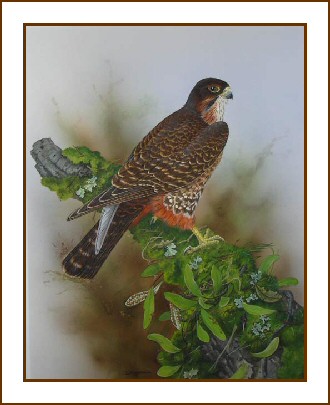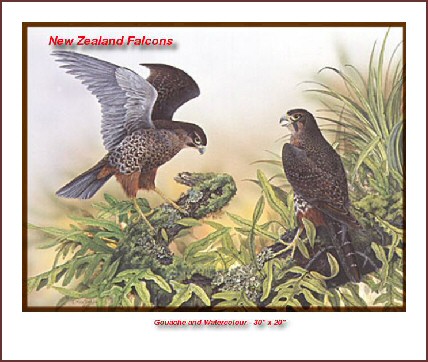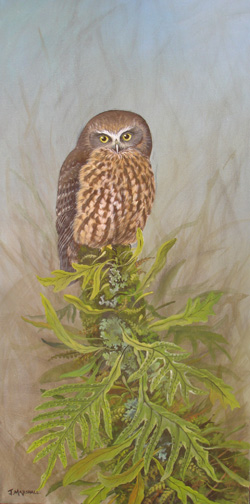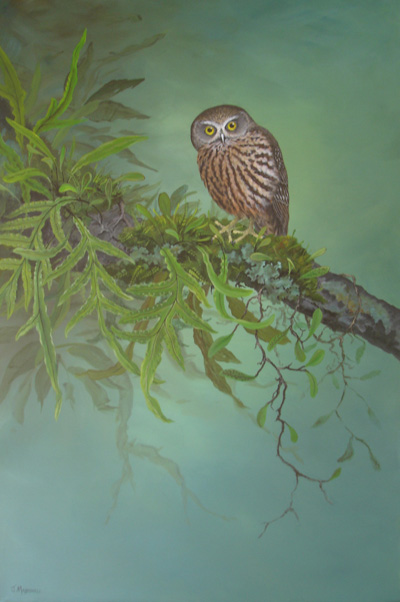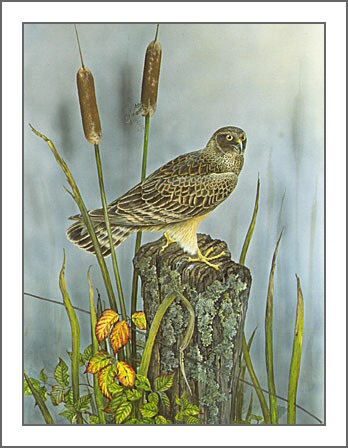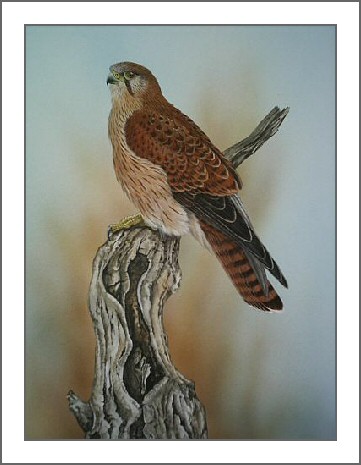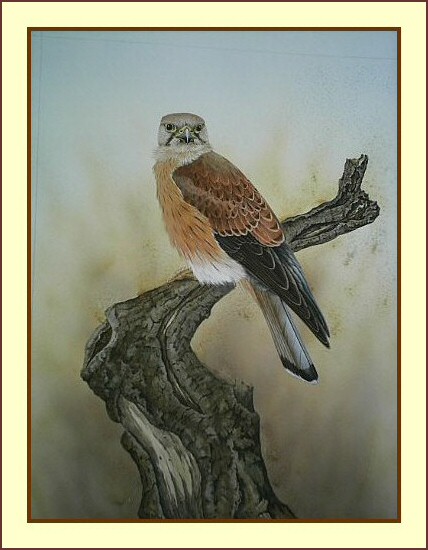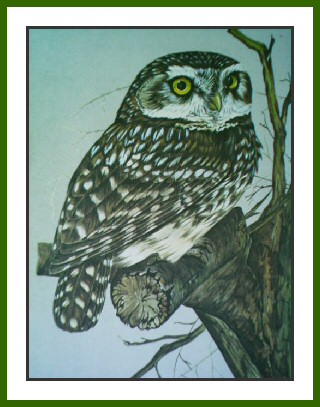

|
SCROLL DOWN TO FIND THE BIRDS OF PREY THAT CAN BE FOUND IN NEW ZEALAND: NZ FALCON; MOREPORK; AUSTRALASIAN HARRIER; NANKEEN KESTREL; LITTLE OWL.
NEW ZEALAND FALCON / Karearea |
||
|---|---|---|
|
New Zealand Falcon Falco novaeseelandiae FAMILY: Falconidae Endemic and fully protected. About half the size of the Harrier, with the females being much larger than the males. The eye skin, cere and legs and feet are yellow in the adult and lead-grey in the immature bird. Immature birds are generally dark black-brown above and chocolate-brown below. They have a piercing whistle or scream 'Kek-kek-kek'. NZ Falcon are found throughout NZ in native bush and isolated high back-country valleys, sometimes appearing small towns. Food includes birds up to duck size and small mammals like mice. Breeding is from October to November and the nest is of sticks or grass on steep slopes with overhanging rocks or in high trees. The eggs, 2-4, are a rich reddish-brown with darker blotches. The female only incubates. Incubation and fledging takes almost 3 months. Wing size Male: 230-260mm Female: 265-305mm. 4th Primary wing feather is the longest. Egg: 45 - 51.8 x 34.2- 37.4mm Tail Male: 164-195mm Female:195-229mm. Tarsus: Male 55-58mm Female: 60-62mm The bill is toothed and the feet featherless. The wing is long and sickle shaped when in flight. The feathers of the falcon were worn by Maori warriors as a sign of bravery.
MOREPORK / Ruru
Morepork Ninox novaeseelandiae FAMILY: Strigidae Native and also found in Australia and New Guinea. Fully protected. Nocturnal and usually heard rather than seen. Their call is a clear 'quor-coo' with a falling second syllable. They also have a harsh and vibrating schreech. Found throughout NZ in native bush and introduced forest, parks and gardens. They feed on moths and insects, mice, rats, lizards and small birds. They can often be seen at dusk sitting on a prominent perch or 'hawking' for food. Breeding is from October to November and the nest is usually in hollow trees or dense clumps of vegetation. They rarely nest in the open. The eggs, 2-3, are white. Only the female incubates and cares for the young.
AUSTRALASIAN HARRIER / Kahu
Australasian Harrier Circus approximans FAMILY: Accipitridae Native and also in Australia and the SW Pacific. Fully protected. This is a large bird of prey and when in flight often soar with the wings tipped upward making a broad, fingered 'vee' image. Young birds are dark chocolate brown with white rump and back of neck patch, while adults are lighter with some old males appearing almost white with silvery-grey wings. Harrier are common throughout NZ except in heavily forested areas and alpine areas. Usually seen singly or in pairs, and sometimes flocking at night roosts in swamps. Food consists of small animals and birds, insects, lizards, carrion, and road kills on which they often feed. Breeding is from October to December and the nest is a platform of tussock and small sticks on the ground, mainly in swamps and scrub areas. The eggs, usually 4, are chalky-white.
NANKEEN KESTREL [female]
Nankeen Kestrel Falco cenchroides FAMILY: Falconidae A visitor to NZ from Australia and New Guinea and recorded with increasing frequency in NZ since 1889. Smaller than the NZ Falcon, with a cinnamon-brown back and pale undersides. They have a habit of 'hovering' in flight against the wind while searching the ground for food. Nankeen Kestrels hunt only over open country, especially paddocks. They feed in flight and on the ground on birds, lizards, insects and small mammals. They breed in Australia from September to December. The nest is high in a tree, of twigs, lined with leaves, or sometimes the deserted nest of another bird. The eggs, 3-7, are buff coloured with many blotches of brownish-red. Only the female incubates. NANKEEN KESTREL [male]
LITTLE OWL Little Owl Athene noctua FAMILY: Strigidae Introduced from Germany to Otago in 1906. Partially protected. Smaller and lighter in colour than the Morepork. The Little Owl is diurnal and can be seen flying and hunting during the day. It has a dipping flight with rounded head and wings. Found in the South Island except for mountain ranges, in open country and forest edges. They can often be seen sitting on fence posts. They feed on mice, insects, lizards, worms and sometimes small birds. Breeding is from September to December. The nest, of no material, is in hollow trees or holes in banks or buildings and sometimes in deserted rabbit burrows. The eggs, 2-5, are round and pure white.
|

Copyright(c) 2006 Janet Marshall. All rights reserved.
myid@myhost.com
nbsp;
nbsp;














